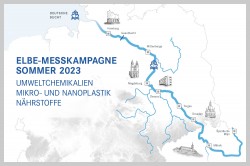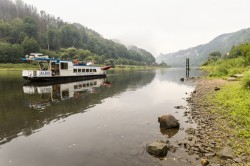Press Release, 26. June 2023
How polluted is the Elbe River?
Helmholtz researchers trace the path of environmental chemicals, nano- and microplastics, and nutrients from the Elbe to the North Sea
Germany’s watercourses, including the Elbe River, are polluted by external discharges from industry, agriculture, and sewage treatment plants. However, this pollution changes along the course of the river - as a result of many sources of pollution and because degradation processes change the substances. In a joint measurement campaign, researchers from several Helmholtz Centres and the Czech Academy of Science want to take a closer look at how environmental chemicals, nano- and microplastic particles, and nutrients enter the Elbe and then the North Sea, in what concentration and size, and how they are degraded and modified along the way. This year’s Elbe cruise as part of the MOSES research initiative will begin in the Czech Republic at the end of June and end in the German Bight in mid-September. From 3 to 11 July, the research vessel "Albis" of the Helmholtz Centre for Environmental Research (UFZ) will be travelling between Schmilka on the Czech-German border and Geesthacht.
The Elbe River stretches 1,094 km through the Czech Republic and Germany from its source in the Giant Mountains to its mouth near Cuxhaven. It flows through large cities such as Dresden and Magdeburg, and is fed by larger rivers such as the Saale, the Havel, and the Mulde, some of which are heavily polluted, and countless smaller tributaries. It also receives discharges from sewage treatment plants, and passes through farmland and meadows. This means that much of what is discharged into the environment of the catchment area ends up in the Elbe in some form or another. For example, there are environmental chemicals, nano- and microplastic particles, and nutrients. "Our aim is to measure the material discharges and their concentrations from the source of the Elbe to the German Bight. In this way, we want to develop a model that takes into account the distribution and dilution of the pollutants in the river in order to draw conclusions about which processes the pollutants are subject to", says Dr Ute Weber. At the UFZ, she heads the MOSES research initiative in which nine Helmholtz research centres are analysing the consequences of extreme hydro-meteorological events on the Earth and the environment.
What is special about this year’s Elbe campaign is that, in addition to the UFZ as the coordinating research institution, three other Helmholtz Centres are involved: the Helmholtz Centre Hereon, the GEOMAR Helmholtz Centre for Ocean Research Kiel, and the Alfred Wegener Institute, Helmholtz Centre for Polar and Marine Research (AWI). With their research vessels, they are investigating individual river sections and coastal areas of the North Sea. This cooperation was tested for the first time during the MOSES dry run "Elbe 2020". "At that time, we successfully tested the cooperation of the coordinated sensor and measurement systems as well as the logistics and organisation from Schmilka to the German Bight", says Weber. The operational logistics were continually refined in the following campaigns so that they can now be reused for new research objectives such as the fate of micro pollutants or plastics.
This year, the pollutants are being investigated along the entire gradient - from the source of the Elbe to its mouth in the North Sea. From 27 to 29 June, the Institute of Hydrobiology of the Academy of Sciences of the Czech Republic will take over the sampling on the approx. 370-km-long section from the source to the Czech-German border on the Czech side. However, because the Elbe is dammed on the Czech side, there is no research vessel there - unlike in Germany. The water and sediment samples are therefore taken from bridges or at dams. From the border to the Geesthacht barrage, the UFZ research vessel "Albis" will then be deployed in the first two weeks of July followed by the Hereon research vessel "Ludwig Prandtl" from Geesthacht to Cuxhaven (end of August). In addition to the "Ludwig Prandtl", the GEOMAR research vessel "Littorina" and the AWI research vessel "Uthörn" will take over the coastal area of the North Sea at the beginning of September.
Contents of the "Elbe 2023" monitoring programme
Dr Werner Brack, an environmental chemist at the UFZ, is responsible for the studies on environmental chemicals. "We want to record and analyse a range of different organic chemicals dissolved in water or bound to suspended matter downstream from the Czech Republic to the German Bight", he says. These include more than 600 substances such as pharmaceutical residues, endocrine disruptors, preservatives, polyfluoroalkyl substances (PFAS), pesticides, industrial chemicals, and surfactants. They are degraded, transformed, mixed with discharges from various sources, and/or diluted. "The aim is to determine more precisely the discharges from agriculture, sewage treatment plants, industry, and residential areas into the Elbe and thus the pollution of the river", says Brack. In order to determine this "chemical footprint", researchers take water samples - both in the Czech Republic from the banks of the Elbe and in Germany at 22 sites in the Elbe as well as from land at six tributaries and eight sewage treatment plants. The researchers are also using non-target analysis, which can be used to identify unknown compounds in water samples based on their molecular mass. "We look for patterns in chemical mixtures so that we can trace them back to sources such as agriculture, industrial operations, road traffic, or settlements", says Brack. So far, this research approach has been pursued mainly in laboratory experiments. But the measuring programme in the Elbe offers much more realistic conditions.
Dr Annika Jahnke, another environmental chemist at the UFZ, coordinates a team of researchers focusing on the transport and distribution of nano- and microplastics and their associated chemicals such as plasticisers and UV stabilisers. "The main sources for the frequent occurrence of plastics in the oceans are on land. And rivers play an important role in the distribution of these plastics. We suspect that many nano- and microplastic particles are transported into the North Sea via the Elbe. We therefore want to investigate how the particles and related chemicals are distributed - from the source to the North Sea", she says. She wants to quantify just how much plastic enters the sea this way. In addition to particle analysis, her team has selected around 150 substances for the measurement and analysis programme. "These long-lasting substances are potentially toxic to humans, organisms, and the environment because they are thought to affect the hormone system and tend to accumulate in living organisms", says Jahnke. She is taking around 30 sediment and numerous water samples along the Elbe and in the German Bight. These will be analysed in the Helmholtz research laboratories.
As a third thematic focus, the researchers are interested in nutrients. A team coordinated by UFZ river ecologist Dr Norbert Kamjunke wants to measure the concentrations of nutrients such as nitrate, phosphate, and silicon as well as organic compounds such as carbohydrates and humic substances and determine the nutrient uptake by algae. This uptake is subject to strong fluctuations in the course of the river. First, the algae grow in masses in the inland Elbe and absorb nutrients. As a result of this, the concentrations of nitrate and phosphate in the water decrease. The algae produce a lot of oxygen through photosynthesis, and the pH value increases. "In the estuary below the port of Hamburg, the flow velocity decreases; the algae sediment and degradation processes lead to oxygen depletion. Dissolved nutrients are released again and transported into the North Sea, where they can once again lead to algae growth", explains Norbert Kamjunke, who is leading the Elbe voyage on the "Albis" for the UFZ and coordinates the entire campaign. By taking 70 water and sediment samples, the researchers aim to quantify how much nutrient material is transported from the land into the Elbe and coastal waters. "We want to describe a gradient for nutrient distribution from the source to the sea", says Kamjunke. The preliminary results for the three focal areas will not be expected until the end of the year at the earliest.
MOSES stands for "Modular Observation Solutions for Earth Systems". In this initiative coordinated by the UFZ, nine research centres of the Helmholtz Association have jointly built mobile and modularly deployable observation systems between 2017 and 2021. They are thus able to study the effects of temporally and spatially limited dynamic events such as extreme precipitation and runoff events or droughts on the long-term development of earth and environmental systems. MOSES has been in regular operation since 2022.
Current information on MOSES:
MOSES website: www.moses-helmholtz.de
For this measurement campaign, the specialist contacts will be arranged via the respective press offices. Please contact:
1. the UFZ press office (presse@ufz.de) for any questions about the campaign/the navigation of the Elbe River from the Czech border to the barrage in Geesthacht
2. the Hereon press office (presse@hereon.de): for any questions on the navigation of the Tidal Elbe from the Geesthacht weir into the German Bight
3. the AWI Press Office (medien@awi.de) or the GEOMAR Press Office (media@geomar.de) for any questions about the measurements in the German Bight
Further information
UFZ press office
Susanne Hufe
Phone: +49 341 6025-1630
presse@ufz.de
In the Helmholtz Centre for Environmental Research (UFZ), scientists conduct research into the causes and consequences of far-reaching environmental changes. Their areas of study cover water resources, ecosystems of the future, environmental technologies and biotechnologies, the effects of chemicals in the environment, modelling and social-scientific issues. The UFZ employs more than 1,100 staff at its sites in Leipzig, Halle and Magdeburg. It is funded by the Federal Government, Saxony and Saxony-Anhalt.
www.ufz.deThe Helmholtz Association contributes to solving major challenges facing society, science and the economy with top scientific achievements in six research fields: Energy; Earth and Environment; Health; Key Technologies; Matter; and Aeronautics, Space and Transport. With some 39,000 employees in 19 research centres, the Helmholtz Association is Germany’s largest scientific organisation.
www.helmholtz.de

